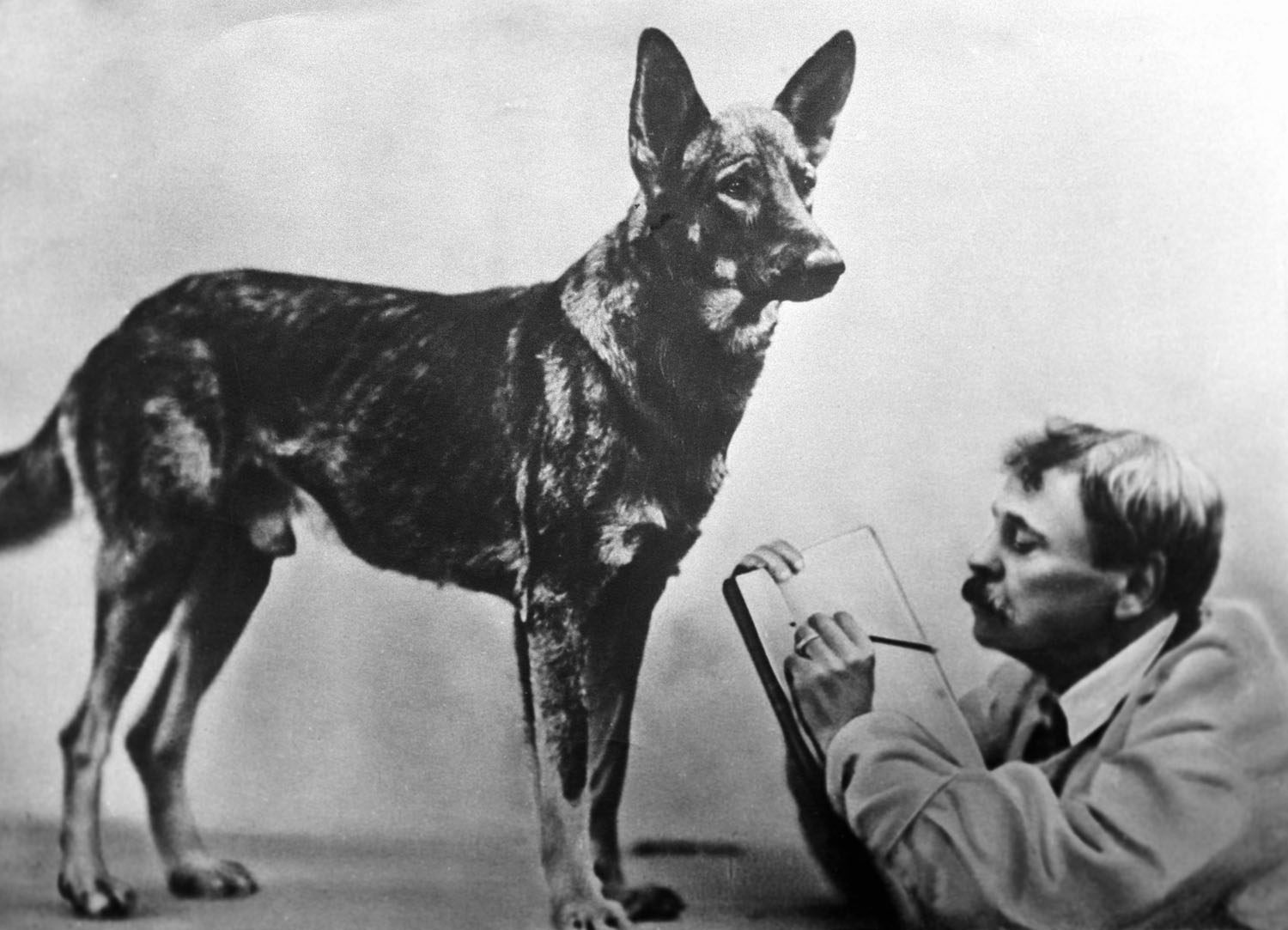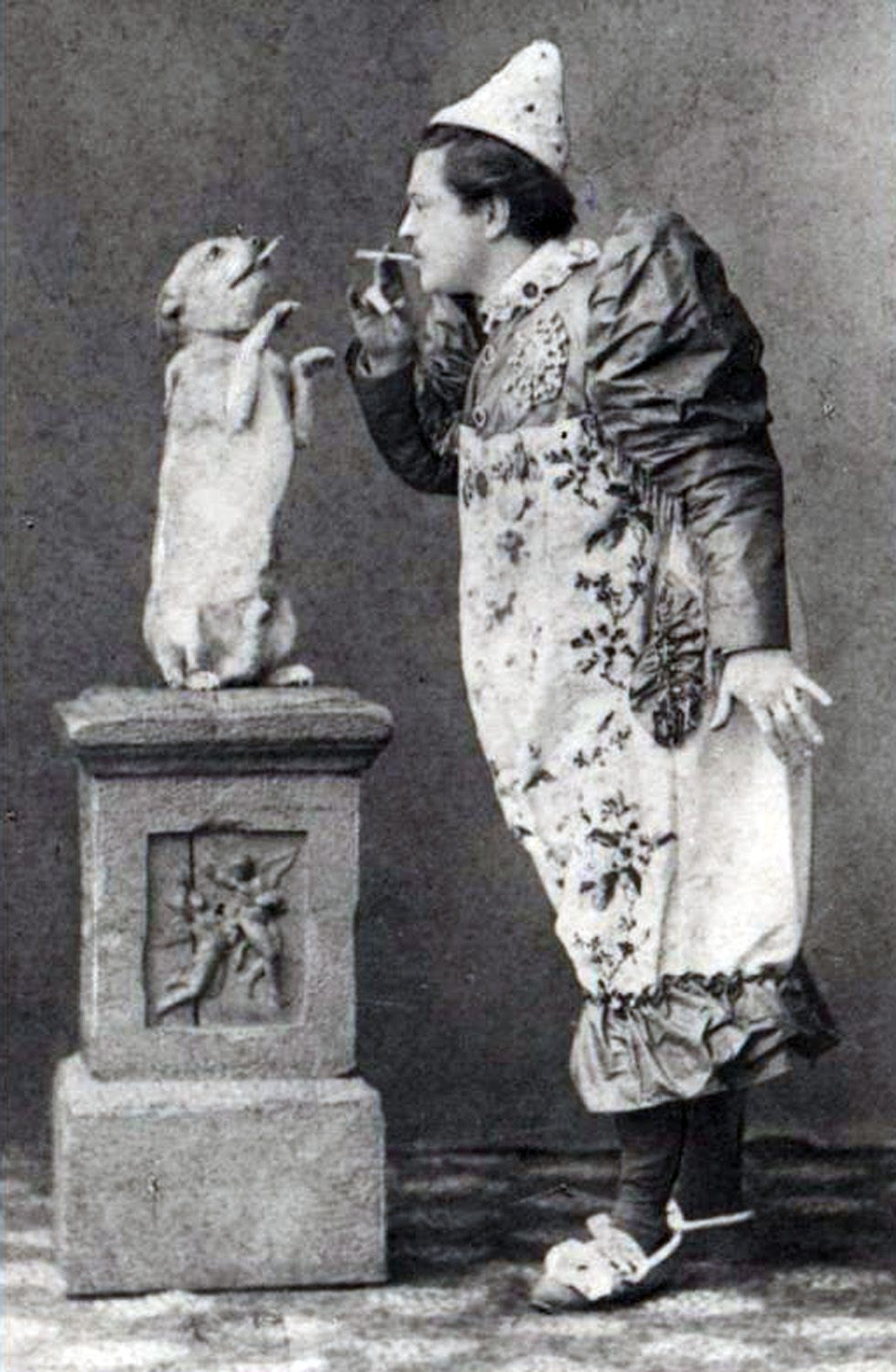How a Soviet Circus Clown Tried to Prove That Dogs Can Be Psychic
In the 1920s, USSR scientists investigated “biological radio communications,” more popularly known as telepathy.

Three years after he started to study telepathy, on August 20, 1922, Bernard Bernardovich Kazhinskiy arrived as part of a four-man delegation at the labs of Vladimir L. Durov, Russia’s most famous animal trainer. Durov was almost 60, and he’d spent most of his life in the circus. At first, he had been a trapeze artist and clown, but as the years passed, his act began to focus on animals—dogs, monkeys, ducks, geese, goats, guinea pigs, bears, lions.
Over time, Durov became known for his ability to communicate with trained animals by “mental suggestion,” which was exactly what interested Kazhinskiy. He wanted to unlock the mysteries of what he called “biological radio communications,” and Durov and dogs seemed like the perfect candidates for the animal experiments he wanted to conduct. Under the Soviet government, Durov’s home had become a center for research on animal psychology, and that day, after the head of the delegation kissed Durov in greeting and made introductions, everyone agreed—Kazhinskiy would come work in Durov’s lab.
Over the course of about two years, Durov and Kazhinskiy would conduct close to 1,300 experiments testing telepathic commands on dogs. This line of research would come to have more importance than most investigations of psychic phenomena: In the decades that followed, it would lead into a Cold War battle to obtain unconventional weapons, during which both sides tried to enhance military parapsychological capabilities and, most famously, America experimented with “men who stared at goats” in order to try to stop their hearts. As Kazhinskiy noted in his 1962 report on his work, the U.S. would eventually become quite interested in telepathy, but “it appears that the main reason… is that the results might be of great military significance.”
In the 1920s, though, Kazhinskiy wanted only to see if Durov could psychically communicate simple ideas to his dogs. According to Kazhinskiy’s later report, translated in the 1960s by the U.S. Air Force’s Foreign Technology Division, they succeeded.

Kazhinskiy had started his career as an electrical engineer working in radio research, but he had also been fascinated by the possibility that living creatures could broadcast information by some radio-like means. “I had to find in the human organism the elements that were structurally and functionally similar to the basic components of a transmitting and receiving radio station,” he wrote in his book, Biological Radio Communications. “I had to make a thorough study of the nervous system.”
Kazhinskiy wasn’t the only Soviet scientist interested in this line of research, as Wladimir Veminski writes in Homo Sovieticus, a newly translated exploration of “Brain Waves, Mind Control, and Telepathic Destiny” in the Soviet era. A few years before Kazhinskiy joined Durov’s lab, another scientist, Vladimir M. Bekhterev, a rival of Ivan Pavlov, had presented Durov’s work at the Institute for Brain Research, describing his technique for transmitting the commands. Nor were the Russians the only ones investigating dogs’ psychic connections: in Germany, around the same time, one wealthy parapsychology enthusiast tried to measure the psychic bond between man and dog.
To use his mind to give a command to a dog, Durov would start by looking deeply into the dog’s eyes. He would direct all his mental powers toward imagining the exact task the dog was to perform, as if he were looking through the dog’s own eyes. After implanting the idea in the dog’s brain, Durov would give the order to act it out.
Here’s how he described giving a telepathic command to a dog named Mars: “I look into Mars’ eyes or, rather, very deep into his eyes and beyond them. I make passes at the dog, stroking him slightly on the sides of his head, above the mouth, the shoulders, barely touching his fur… The dog points his nose almost vertically, as if it were falling into a trance. My movements deprive the dog of all his will, and he remains in such a state as if he were part of my internal ‘ego.’ A communication or ‘psychic contact’ has thus been established between my thoughts and Mars’ subconsciousness.”

According to his memoir, Durov first experienced his power to affect dogs this way under dramatic circumstances. When he was young, he bet his friends that he could go into an abandoned house where a dangerous dog was kept locked up and the dog would not touch him. When he entered the dog rushed at him, but Durov caught his eye and kept it. The dog slowed, stopped, and retreated, as Durov mentally compelled him to stay back. Durov left the house safe, untouched by the dog, and immediately passed out. (It’s possible, of course, that Durov managed to influence the dog with his body language, not with telepathic powers. In his book, Kazhinskiy does mention that telepathy has skeptics, but he doesn’t seem to consider any other possible explanations for the phenomena he’s observing. Those skeptics, too, are often convinced to Kazhinskiy’s side after seeing the results of his experiments.)
In his time with the animal trainer, Kazhinskiy documented 1,278 experiments on telepathic dog training over 20 months.
In one experiment, on November 17, 1922, Durov and another experimenter choose an object for a dog (Mars, again) to fetch—a telephone book in a room down the hall from the lab. The first time Durov tried to tell Mars to get the book, the dog ran from the armchair where he was seated to the middle of the room. The second time, the dog tried to close the room’s door. The third time, though, he went through the door, into the hallway, into the other room, and searched about. When he found the telephone book, he grabbed it in his mouth and brought it back to the original room. “Despite the first two unsuccessful attempts, the experiment must be considered as highly successful,” Kazhinskiy writes.
In another set of experiments with a different dog, Pikki, the researchers brought the animal to an unfamiliar apartment and gave him a series of telepathic commands. Following Durov’s mental instructions, he performed a series of tasks; for instance, he “jumped off the chair, ran to the chair near the wall and just as quickly jumped up on the round table and, standing on his hind legs, reached the lower part of the portrait and began to scratch it with his paws.”

Kazhinskiy also built a Faraday cage, which interrupts the transmission of electrical signals, to test his theory about how Durov was communicating telepathically with the dogs. He had the trainer try his mental command strategy while sitting inside the shut cage and with the door open. “The very first trial tests revealed that my assumptions had been correct,” Kazhinskiy writes. “When the cage door was closed, V.L. Durov sitting inside was unable to transmit to the test animal (the dog Mars) outside a mental assignment. But as soon as the door was opened, Mars carried out every order with precision.”
Overall, Kazhinsky reports, 696 of their experiments with mental suggestions to dogs were successful; 582 were not. According to a zoologist/statistician at Moscow State University, an analysis of the results showed that “the dogs’ responses were not accidental but produced under the influence of the experimenters.” Telepathy apparently worked. With dogs, at least.

In one experiment, though, Kazhinskiy had Durov experiment on him.
“Compel me mentally to make some movement, I am curious to know what I will think in the process,” Kazhinskiy told Durov. “Can you do it?”
“Easily,” Durov said. “You just sit quietly.”
They were sitting alone, across from each other at a table, and Durov wrote down a command on a piece of paper. The two men locked eyes.
“I didn’t feel anything in particular, but suddenly and automatically I touched the skin behind my ear with the fingers of my right hand,” Kazhinskiy writes.
Immediately Durov handed him the piece of paper, on which he had written, “Scratch behind your right ear.”
These experiments had an innocence and exuberance to them: Kazhinskiy seems to be motivated by the pure spirit of scientific industry. But as conflict between the U.S. and the Soviet Union arose following World War II, both sides would try to harness this type of telepathic power for more nefarious means, including long-distance psychic spying and the aforementioned goat assassinations. None were as successful as a Durov’s dog experiments were reported to be, though. Since the 1920s, there has been no revolution in telepathic dog training; later investigations have come up short. Perhaps Durov had some special mental powers; perhaps he was a very, very good animal trainer. These experiments do seem easily replicable, though. If you succeed in transmitting a telepathic command to a dog… let us know?





























Follow us on Twitter to get the latest on the world's hidden wonders.
Like us on Facebook to get the latest on the world's hidden wonders.
Follow us on Twitter Like us on Facebook